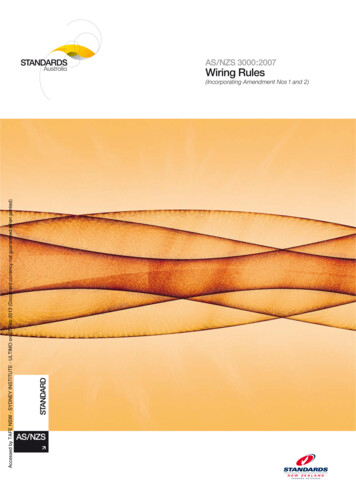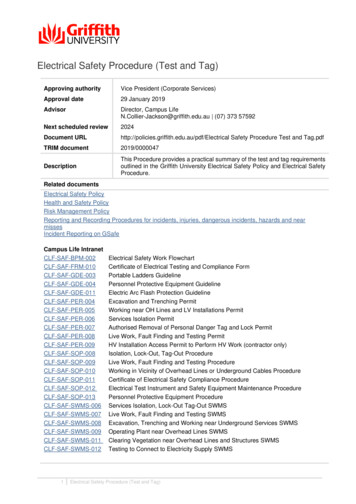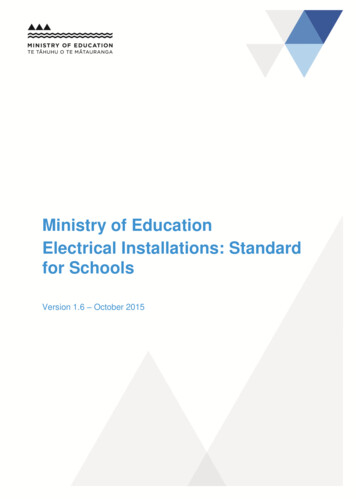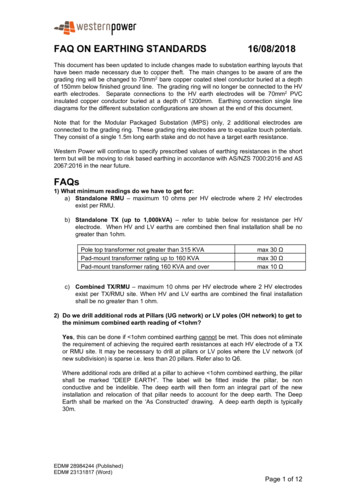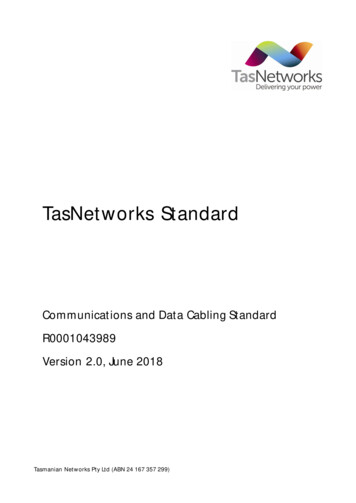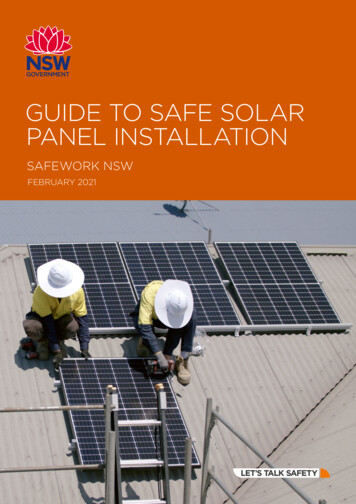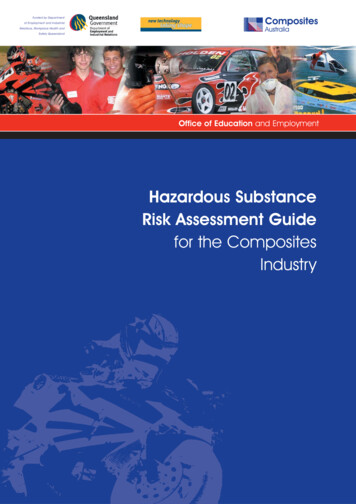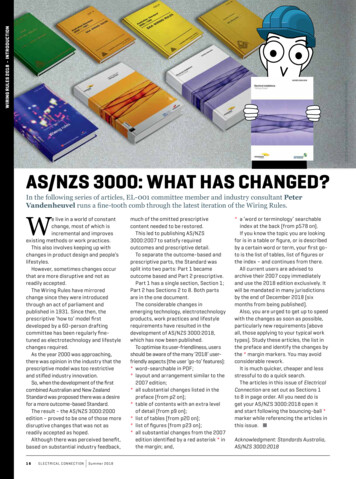
Transcription
BOOKS IN THIS IMAGE KINDLY PROVIDED BY ROY SANDSWIRING RULES 2018 - INTRODUCTIONAS/NZS 3000: WHAT HAS CHANGED?In the following series of articles, EL-001 committee member and industry consultant PeterVandenheuvel runs a fine-tooth comb through the latest iteration of the Wiring Rules.We live in a world of constantchange, most of which isincremental and improvesexisting methods or work practices.This also involves keeping up withchanges in product design and people’slifestyles.However, sometimes changes occurthat are more disruptive and not asreadily accepted.The Wiring Rules have mirroredchange since they were introducedthrough an act of parliament andpublished in 1931. Since then, theprescriptive ‘how to’ model firstdeveloped by a 60-person draftingcommittee has been regularly finetuned as electrotechnology and lifestylechanges required.As the year 2000 was approaching,there was opinion in the industry that theprescriptive model was too restrictiveand stifled industry innovation.So, when the development of the firstcombined Australian and New ZealandStandard was proposed there was a desirefor a more outcome-based Standard.The result – the AS/NZS 3000:2000edition – proved to be one of those moredisruptive changes that was not asreadily accepted as hoped.Although there was perceived benefi t,based on substantial industry feedback,16ELEC T RIC A L CONNEC T IONSummer 2018much of the omitted prescriptivecontent needed to be restored.This led to publishing AS/NZS3000:2007 to satisfy requiredoutcomes and prescriptive detail.To separate the outcome-based andprescriptive parts, the Standard wassplit into two parts: Part 1 becameoutcome based and Part 2 prescriptive.Part 1 has a single section, Section 1;Part 2 has Sections 2 to 8. Both partsare in the one document.The considerable changes inemerging technology, electrotechnologyproducts, work practices and lifestylerequirements have resulted in thedevelopment of AS/NZS 3000:2018,which has now been published.To optimise its user-friendliness, usersshould be aware of the many ‘2018’ userfriendly aspects (the user ‘go-to’ features):* word-searchable in PDF;* layout and arrangement similar to the2007 edition;* all substantial changes listed in thepreface (from p2 on);* table of contents with an extra levelof detail (from p9 on);* list of tables (from p20 on);* list of figures (from p23 on);* all substantial changes from the 2007edition identified by a red asterisk * inthe margin; and,* a ‘word or terminology’ searchableindex at the back (from p578 on).If you know the topic you are lookingfor is in a table or figure, or is describedby a certain word or term, your first goto is the list of tables, list of figures orthe index – and continues from there.All current users are advised toarchive their 2007 copy immediatelyand use the 2018 edition exclusively. Itwill be mandated in many jurisdictionsby the end of December 2018 (sixmonths from being published).Also, you are urged to get up to speedwith the changes as soon as possible,particularly new requirements (aboveall, those applying to your typical worktypes). Study these articles, the list inthe preface and identify the changes bythe * margin markers. You may avoidconsiderable rework.It is much quicker, cheaper and lessstressful to do a quick search.The articles in this issue of ElectricalConnection are set out as Sections 1to 8 in page order. All you need do isget your AS/NZS 3000:2018 open itand start following the bouncing-ball *marker while referencing the articles inthis issue. Acknowledgment: Standards Australia,AS/NZS 3000:2018
2018 WIRING RULES - INTROA NOTE FROM THECOMMIT TEE CHAIRMANTechnological developments and input from stakeholders makerevision of the industry bible quite a task. Gary Busbridge reports onthe 2018 update to AS/NZS 3000.By now I trust that all stakeholders in the electrical industry have theirown genuine copy ofthe 2018 Wiring Rules.Unfortunately, a couple of counterfeit versions have been floating around.This is verydisappointing but par for the course in these times of non-conformingproducts.It has been a long ride since the 2007 edition. The revision, which startedabout sevenyears ago, has been the focus of many long debates at commit tee level.Our first meetingswere about setting the scope of the revision, with all parties providing information and detailon changes and additions.Technological and work practice changes were required, and therewas also a call for moreclarity in the Wiring Rules.The EL-001 commit tee has about 35 members from all sectors of theindustry. Therepresentation includes unions, electrical contracting and engineering associations,educators, regulators, consumer advocates, manufacturers, testingand certification specialists, and network associations in Australia and New Zealand.About 20% of the members hail from the Land of the Long White Cloud.Thanks go to our hard-working Standards Australia project managers and to thecommit tee for all their intense hard work to bring this publication tocompletion.This was also a ‘first’ in that many members took the proposals forchange and clarity tothe electrical industry, in essence to get crucial feedback. Much information was gleaned,helping us to finesse the changes as much as possible before the publiccomment phase.Ah, but the best laid plans there was an unprecedented number ofpublic comments tothat draft, and I thank all of you in the industry for your input.Unfortunately, the process for adding comments was a little clumsyand many commentswere not registered. However, we did receive more than 2,000 comments – huge by anymeasure – and we tried our best to deal with them.Implementing more RCDs in buildings is seen as the big-ticket item,but the addition ofelectric vehicle charging, arc fault detection and DC installations isnecessary to keep abreastof emerging technologies.The losses of power due to disaster – and potential effects on the aged,infirmed or disabled – are important matters and we have added some detail.Further detail on discrimination and selectivity of control devices hasalso been provided.There are about 200 changes or additions, many providing clarity foreveryday workpractices. To make things easier a red asterisk on the left side of the pageindicates the changes.Rest assured that work has started on an amendment to add manyof the public comments(made as the revision was under way) and feedback from the releaseof the 2018 edition.Most of these comments were parked during the process, as they wereseen to be out ofscope and needed much research.No rest for the wicked, they say. The EL-001 commit tee is facing thechallenge to continueproviding up-to-date and technologically advanced detail for AS/NZS3000.- Buzzw w w.elec tricalconnec tion.com.au 1 7ALL DIAGRAMS SOURCEDFROM AS/NZS 3000:2018.
Wiring rules 2018 - parT 1, seCTion 1The foundaTionLet’s start at the very beginning, with scope, applications and fundamental principles to set the scene.The importance of Part 1, Section1 is expressed in the title of thisarticle – it is the foundation forthe whole document, stipulating theminimum that users must achieve inorder to comply.This section may be the least used ineveryday situations, but without it theStandard could not exist.The section is crucial because:* It sets out all underlying principlesfor what is required. It is what Part2, Sections 2-8 (the detailed how-toor prescriptive ‘deemed to comply’parts) are based on and underpins the‘why’ for Part 2 practices to confirmcompliance.* It also provides the opportunity andmechanism for dealing with uniquesituations, such as the need to remedya non-compliance that is unable to bedone practically by a Part 2 solution,or the introduction and use of new orinnovative technology. It provides theoption to use a Part 1 solution.However, it should be noted thatthe use of a Part 1 solution is (or maybe) subject to the following of certainstringent processes, procedures andverification requirements in differentjurisdictions.Such solutions should never beundertaken in a cavalier manner,because they must always meet thehigh-level fundamental requirements.Yet used correctly, such solutions canlead to industry and electrical installationinnovation or offer the possibility for a‘get out of jail card’ in situations wherecompliance with a Part 2 remedy may notbe practical or possible.Changes lisTed in The prefaCeinClude:* new and revised definitions;* removal of the mains supplydefinition;* renaming direct and indirect contactto basic and fault protection;* IP ratings;* earthing conductors to be green/yellow;18ELEC T RIC A L CONNEC T IONSummer 2018* references to AS/NZS 3018 Electricalinstallations - Domestic installationsre-homed to other Standards;* requirements for alterations andrepairs clarified; and,* guidance on Part 1 solutions.subsTanTial Changes from The2007 ediTion in parT 1, seCTion 1 inpage order inClude:* The Standard now also recognisesmitigation of foreseeable adverseeffects of disruption to supply. Thisled to the creation of new Appendix MReducing the impact of power supplyoutages focused on continuity of supplyfor active assisted living and homecaremedical situations. This is an informativeappendix providing guidance to users forreference in situations where the owneror occupier has identified the possibleneed to mitigate such adverse effects.(p33, p559)* Differentiation between ‘accessible’(capable of being reached) and ‘readilyaccessible’ (capable of being reachedquickly and unobstructed). (p34)* Clarification that an alteration is amodification of an installation but arepair is not. (p35)* Introduction of arc fault detectiondevices (AFDDs). This led to thecreation of a new Appendix OInstallation of arc fault detectiondevices. This is an informativeappendix providing guidance to users insituations where the owner or occupierhas identified the possible need tomitigate the risk of low-level arcingfaults in wiring, leads and appliances(such as electric blankets) and possibleresultant fires. Use of these devices isbecoming more prevalent in the UnitedStates and Europe. (p35, p565)* Definition of ‘authorised person’is simplified as ‘selected by theperson in charge of the premises’.It now excludes the terms ‘licensedelectrical contractor’ or ‘electrician’(although these can be authorisedpersons, where selected). (p36)* Definition of ‘de-energised’ isadded as ‘being separated from thesource of supply but not necessarilyisolated’. Two cross-referencespreviously under Damp situations aremoved under this new heading. (p40)* Definition of ‘electrical installation,residential’ is added to define portionsof an electrical installation associatedwith living units to differentiate it fromnon-residential portions of the samebuilding or installation. Some examplesare given. (p42)
WIRING RULES 2018 - PART 1, SECTION 1* Definition of ‘electrical vehicle (EV)’ isadded as ‘any vehicle propelled by anelectric motor drawing current fromrechargeable batteries’ – clarified as‘on board’ batteries. (p42)* Definition of ‘energised’ as ‘connectedto a source of electrical supply’ isadded. (p43)* Definition of ‘fire mode’ is added as ‘aspecific mode of operation instigatedby a fire alarm being activated withinthe building’. (p44)* Definition of ‘functional unit’ as ‘partof a switchboard assembly’ andclarifying that ‘conductors connectedbut external to it’ not being part of itis added. (p45)* Definition of ‘isolated’ as ‘separatedfrom all sources and renderedincapable of being unintentionallyenergised’ is added. (p46)* Definition of ‘lamp’ as ‘an item thatemits light produced by electricity’ isadded. (p46)* Definition of ‘lift’ as ‘capable of raisingor lowering persons but excludinghoists, dumb waiters, escalators ortravelators’ is added. (p46)* Definition of ‘live’ as ‘energised orsubject to hazardous induced orcapacitive voltages’ is added. (p47)* Definition of ‘main switch’ as ‘a switchwith the primary function of isolating asupply to an electrical installation’ and(subject to labelling) possibly fulfillingregulatory requirements is added.(p47)* Minor revision to definition of ‘MENsystem’ to reflect not all electricalinstallations are MEN systems. Thisis also detailed in changes to othersections. (p47)* Definition of ‘neutral earthedsystem’ as ‘a system where the onlyconnection between neutral and earthis at the generator or transformer hasbeen added. (p48)* Definitions ‘individual’ and ‘combinedoutbuildings’ are added and thediff ering requirements for earthing ineach instance are added. (p48)* Definition of ‘protective earth neutral(PEN)’ as ‘both functions combined ina single conductor’ is added. (p49)* Definition of ‘repair’ as ‘to restore theinstallation to safe after damage hasoccurred’ is added. (p50)20ELEC T RIC A L CONNEC T IONSummer 2018* Definition of ‘safety service’ listingevacuation systems separately, alsoreflecting a major change in liftsidentified as emergency lifts requiringdifferent electrical installationarrangements from lifts not so identifiedas detailed in Sections 2-8. (p50)* Definitions of ‘socket-outlets-multiplecombination’ and ‘socket residualcurrent device’ are added. (p51)* Definition of ‘soft wiring’ as ‘wiringsystems using installation couplers’ isadded. (p51)* Definition of ‘supply, alternative’as ‘to maintain the supply in caseof interruption to the normalsupply’ is added to diff erentiatebetween alternative, normal andsupplementary supplies. (p52)* Definition of ‘supply, normal’as ‘the supply the installationis supplied from under normaloperation’ is added to diff erentiatebetween alternative, normal andsupplementary supplies. (p52)* Definition of ‘supply, supplementary’as ‘a supply intended to operatein conjunction with the normalsupply) is added to diff erentiatebetween alternative, normal andsupplementary supplies. (p52)* Definition of ‘wiring systems’ as‘assemblies made up of one or moreconductors, cable or busbars andparts that secure their fixings andmechanical protection’, is added. (p54)* Note is added to Protection by barriersand enclosures that ‘IP rating shallsuit the environmental conditionsand the relevant mounting positionspecified by the manufacturer’. (p57)* Requirement under Design of anelectrical installation to ‘reduce theinconvenience in the event of a fault’is added. See also the first itemin this list and new Appendix M inthose situations where the owner oroccupier has identified the possibleneed to mitigate such adverseeff ects. (p66, also p33, p559)* Requirements under Selection andinstallation of electrical equipmentare changed, including subheadingEssential requirements (renamedGeneral) item (c) being modifiedto also require compliance withthis Standard. Requirements*****under Installation work practicesinclude additional items (f) addingfurther detail for wiring conductoridentification, (i) dealing withbreathers for condensation issuesand (j) electrical equipment to beinstalled in a manner that maintainsIP ratings. This being brought aboutat least in part due to manufacturerIP ratings often being compromiseddue to incorrect mounting anddrilling for cable entry or mounting.(p68-69)Note 2 is added under Verification(inspection and testing) to drawattention to Appendix K for guidanceon switchboard inspection andverification. (p70, p545)Text under Compliance with therequirements of other Standardsis changed from a reference todomestic installations and AS/NZS3018 to now referring to Cl7.8 and Appendix A for Standardsapplicable to specific electricalinstallations. (p71, p430)Text in Alterations and repairs ischanged with deletion of ‘alterations’from both the previous 2007edition clause title and the text. Asub-heading Alterations has beenadded. The first two paragraphsare replaced with ‘alterations toelectrical installations shall complywith all relevant provisions of thisStandard’. Also, the sentence dealingwith repairs has been re-homedunder its own sub-heading in thisclause and a reference made toAppendix I for current ratings ofimperial cables. (p71, p540)Sentence is added underAcknowledgement by the owneror operator (of a Part 1 solution)requiring that ‘a copy of the designdocumentation shall be retained atsite’. (p72)New clause is added underDocumentation (by the designer)where a Part 1 solution has beenadopted – to place a permanentwarning to that eff ect on the mainswitchboard and on all of thedistribution switchboards that arepart of the Part 1 solution. (p73) -Peter Vandenheuvel
How to handle more volts and amps than you can poke a proverbial stick at.Electrical contractors must dealwith fault currents, arc faultcurrents, over currents, nominalcurrents, over voltage, under voltage,nominal voltage, phase voltage and more.All are diff erent and all (plus morenot listed here) are crucial in makingsure that the installations you designand complete will ‘meet code’, as theAmericans would say.This is the section that describeshow all the key distribution elementsmust come together to ensure thatthe installation is safe and onlythose parts of it that are affectedare turned off when an abnormalsituation arises.As noted: Part 1, Section 1 dealswith all the fundamentals and theirunderlying principles. Part 2, Sections2-8 contain the comprehensive how-tothat turns the statements in Part 1 intodetailed complying instructions.Part 2 is the ‘deemed to comply’go-to part of the Standard. Followit to the letter and you cannot gowrong. It is a guarantee to the userthat if all the relevant clauses ofSections 2-8 are followed correctly,the works will comply.Just as users of Part 1 of thisStandard can comply without referenceto Part 2 (well, theoretically at least),they can also do fully complying workusing only Part 2.So, what’s the major differencebetween using a Part 1 or Part 2 solution?In a nutshell – the ease! Usingonly a Part 1 solution, users mustdemonstrate to the regulator orinspector, in great detail, how each andevery part of the work complies, forevery part of the entire installation.On the other hand, when using onlyPart 2, all that is needed is to verifythat it meets the Part 2 requirementsalready defined – then the certificate ofcompliance is signed.So, do you pick the easy way or thedifficult way? The choice is up to the userbut there is much to be gained by usingPart 2 solutions wherever possible.So why is there no Section 1 in Part2? Well, a decision was made whenthe Part 1 and Part 2 arrangementwas introduced.This allowed the layout andnumbering of the preceding 2000edition to remain. It also preventedany confusion due to having twoelements named Section 1. www.electricalconnection.com.au-Peter VandenheuvelWIRING RULES 2018 - PART 2PART 2: CURRENT CONCERNS
WIRING RULES 2018 - PART 2, SECTION 2GET INTO GEARHere are the minimum requirements for selecting and installing switchgear and control gear.Let’s look at the overall powerdistribution architectureof an installation, includingrequired functions and features, allunder the Section 2 heading Generalarrangement, control and protection.This section deals mainly with powerdistribution. It focuses on:* control and isolation formaintenance, testing, fault detectionand repair;* automatic disconnection of supplyfor over current, fault and earthleakage currents;* protection against over-voltage andunder-voltage conditions;* suitable arrangements forswitchgear and control geargroupings, locations and access;* controlling and protecting reliabilityof other parts of the installation incase of faults; and,* verifying that switchgear and controlgear installation is to manufacturerinstructions.Electricity distribution in allinstallations has to be arranged,installed and controlled.It involves controlling voltages andcurrents that can be a shock hazardand generate considerable operatingtemperatures.22ELEC T RIC A L CONNEC T IONSummer 2018These hazards increase as currentsand voltages get higher, especially inswitchboards or environments thatare already at increased temperatures.Poorly selected or installed switches,circuit breakers and other currentcarrying devices can result in harmfuland destructive failure, and a muchreduced service life.This makes emphasis on carefulselection and reference to manufacturers’instructions crucial to an installation’sperformance, as most equipment has quitedifferent ratings in different environments.Switchgear and control gear can even bedestroyed if improperly used.For instance, the rating for a pieceof equipment in ‘free air’ can bemuch higher than when it is in a smallcompartment – or if surrounded byitems also generating heat.This is reflected in some of thechanges in this section and in the newAppendix K Switchboard requirementsummary.CHANGES LISTED IN THE ‘PREFACE’INCLUDE:* adding switchgear operatingcharacteristics;* origin of sub-mains identification;* operation of main switch details;* position and alternative positions ofoverload device clarification;* expansion of discriminationrequirements;* enhancement of switchboard arcingfault protection;* additional and revised RCDrequirements;* clearances around switchboardsclarified (and increased);* guidance on the use of low-currentarc fault detection devices;* enhancement of requirements for800A and over switchboards; and,* clarification on rising mains and othertee-off s.SUBSTANTIAL CHANGES FROM THE2007 EDITION IN PART 2 SECTION 2INCLUDE:* New item (f) under Selection andinstallation placing more emphasison compliance with additionalrequirements in manufacturerinstructions for diff erent ratings indiff erent installed environments.Refer also above. (p75)* A note is added under Arrangementof electrical installation (d) drawingattention to the need to increasereliability of supply as further detailedin new Appendix M. (p76, p559)
WIRING RULES 2018 - paRt 2, SEctIoN 2* New heading Origin of sub-mains andfinal sub-circuits requiring every submain and sub-circuit to commence atthe main switchboard or a distributionboard and for all the ‘live’ conductorsto be connected at one switchboard’is inserted and ‘common neutral’renumbered. (p76)* New heading Electric vehicle chargingcircuits is added referencing AppendixP and special NZ requirements. (p77)* The heading now Commoncontrol systems (was Commonrequirements), General is elevatedto a sub-section heading nowcovering new sub-section heading Allsystems. The previous headings arerenumbered to follow. A new item (d)adds that the precautions now alsoinclude short-circuiting and earthingas supplementary measures. Theword ‘poles’ under Direct currentsystems is changed to ‘conductors’.(p80-81)* Under Devices for isolation – generalthe word ‘supply’ between ‘active’ and‘conductors’ is deleted to now includeall active conductors, not just theactive supply conductors. Also, theword ‘shall’ has been moved to eachof items (a) to (f) as the opening word.So, there is no material change apartfrom emphasising that each (a) to (f)must be complied with. (p82)* New sub-heading Introduction isslotted in under ‘main switches’above the otherwise unchangedwording below. The later subheadings are renumbered tosuit. Also, the ‘exception’ undersub-heading General dealing withmain switches for alternative orsupplementary supplies is rewordedand the (a) to (g) numbering is now 1to 7. (p83-84)* Word ‘operation’ is added to‘location’ for the heading to nowread Operation and location. A newnote (b) dealing with main switchoperating handles and controlsrequiring manual operation andexcluding electronic touch screensfor main switch operation isincluded with the remaining clausesrenumbered to suit. A new item (e)has been added detailing labellingrequirements for any supplementary24ELEC T RIC A L CONNEC T IONSummer 2018********or alternative supply to identifythe energy source. Under Remotecontrol new item (iii) preventingoverriding or bypassing by PLCor similar and new item (d) foradditional requirements wheretouch screens or PLCs, etc, are usedin conjunction with a main switchare added. (p84-86)Cross-reference list under Appliancesand accessories now includes (i) ‘gasappliances and accessories’ and (k)‘lifts’ with the remainder re-indexedto suit. (p88)Under Emergency switching includingemergency stopping the paragraphmandating an isolating device wherethere is a risk of shock is rewordedbut does not appear to change theintent. (p88)Text under Emergency switchingdevices has slight rewording of (v) formanual reset prior to starting but noapparent change of intent. (p89)Text under Fault protection in (b) hasadded compliance cross-reference tocl 5.7. (p92)Text under Protection againstover current has a new subheading General requirementswith renumbering of the othersub-headings to suit. Also, a noteat the end of that clause dealingwith reduction in current-carryingcapacity numbered as Note 1 andreworded, with Note 2 referencingAppendix I (ratings of imperial cables)added. (p94, p540)Text under Consumer mains (b)and (c) now does not refer to note(6) and text is added after (c) thatthis arrangement is regarded asunprotected consumer mains witha clarification note for unprotectedconsumer mains and crossreferencing added. A new Figure 2.1follows. (p94, p95)Note under Sub-mains and final subcircuits – general arrangements ischanged to now refer to 2.2 (A) and2.2 (B). (p96)The exception under Devices forprotection against both overloadand short-circuit currents is nowreferenced to 2.5.7.2. Note 4regarding screw-type fuses nowrefers to an IEC document. (p96)* A substantial clause Characteristicsof short-circuit protective deviceshas been moved from later in this partof the Standard but not changed. Theother clauses are renumbered to suit,the figures likewise. The figures are alsoreworked with changes. Users shouldacquaint themselves with any changes.(p99-100 and Figures 2.3 to 2.10)* The first paragraph under Protectionagainst switchboard internal arcingfault currents – General is rewordedto include the 800A and overreference previously included in thenote. There has been no change ofintent. (p108)* The first paragraph under Reductionof the probability of the initiation ofa switchboard internal arcing faultreplaces the previous term ‘heavycurrent switchboards’ with the term‘switchboards rated at 800A orgreater per phase’ to clarify the 2007edition intent. (p109)* Figure 2.11 is included, showingwhich are parts of a functional unitand which are not. (p110)* Cross-reference to 2.5.4.5 (a) isadded under Protection afforded byseparate devices. (p111)* Under Co-ordination of protectivedevices, a paragraph is added withdetail on back-up (cascading)of devices with a note to usemanufacturer instructions anda reference to new Figure 2.12.The references in Note 2 are rehomed, and a Note 3 added to clarifyselectivity need not apply whereprotective devices are in series onthe same circuits, such as with UPSconnected supplies. (p112-113)* Under Safety service circuitdiscrimination (selectivity),‘selectivity’ is added to the headingand the text is revised to mandatethe previously more loosely wordedrequirements so that the originalintent is reinforced. The references tofigures are re-homed. (p113)* Under General supply circuitdiscrimination (selectivity), ‘selectivity’is added to the heading and the textrevised to mandate the previouslymore loosely worded requirements.So, the original intent has now beenreinforced. The use of discrimination
***WIRING RULES 2018 - paRt 2, SEctIoN 2*studies has been included in the maintext; it was previously included in thenotes. The reference to figures is rehomed. (p113-115)Under Types of RCD an additionalIEC Standard, IEC 62423 (Type F andtype B residual current operatedcircuit-breakers with and withoutintegral overcurrent protection forhousehold and similar uses), is added.Advice for users to consult the RCDmanufacturer for type selection andAustralia-only and New Zealand-onlyrequirements are added. (p120-123)The heading Additional protection byresidual current devices is renamedfrom Where additional protectionis required and it has been changedsubstantially, including a virtualblanket requirement for RCDs on allfinal sub-circuits in domestic andresidential situations. In addition,all RCDs must be installed at theswitchboard. In non-residentialinstallations RCDs must be providedon all socket-outlet circuits, lightingcircuits, direct-connected hand-heldelectrical equipment and directconnected equipment that representan increased risk of electric shock.In non-domestic non-residentialsituations, for direct-connectedtype circuits up to 32A, the installingof 30mA RCDs should also beconsidered. There are exceptions andother changes, therefore users areadvised to carefully study the newedition so that these requirementsare fully understood. (p119-125)In Home care installations – Australiaonly RCD requirements must complywith AS/NZS 3003 and some of thesemay need to be Type 1 RCDs rated at10mA. (p125-126)Under Alterations to installationsand replacement of switchboards –Australia only RCDs must be installedwhere any sub-circuit is alteredor socket-outlets are added. Also,where all the circuit protection ona switchboard is replaced, unlesscertain exemptions apply. For repairs,where a socket-outlet, luminaire orsingle item is replaced ‘like with like’RCDs are not mandated. There arealso some NZ-only requirements tonote for NZ users. (p126-127, p130)Advice for users to consult the RCD manufacturer for type selection and Australiaonly and New Zealand-only requirements have been added.* Heading Protection against fire hazarddue to arcing fault is new, insertedin place of Switchboards, which isrenumbered to suit. Low-currentarcing faults, as in faulty electricblankets and other appliances, anddamaged wiring and electric cordshave been identified as potentialsources of house and building fires.Low-current arcing fault detectiondevices (AFDDs) have now becomeavailable for use in situations wherethe owner or occupier identifies suchrisk. The information here and in n
The result – the AS/NZS 3000:2000 edition – proved to be one of those more disruptive changes that was not as readily accepted as hoped. Although there was perceived benefi t, based on substantial industry feedback, much of the omitted prescriptive content needed to be restored. This led to publish
